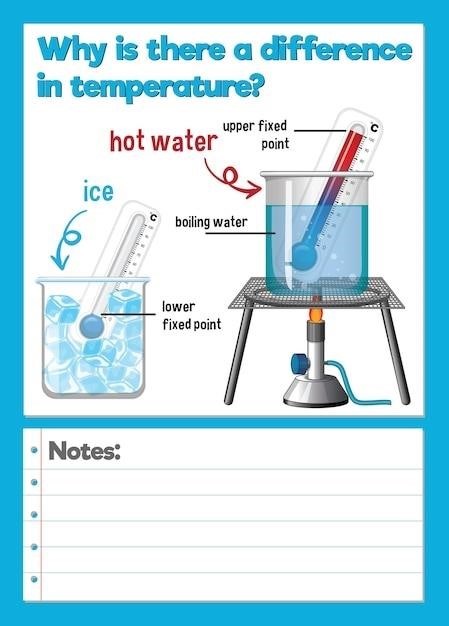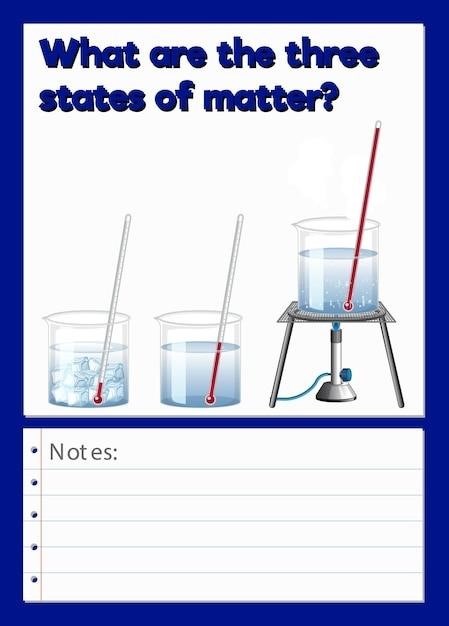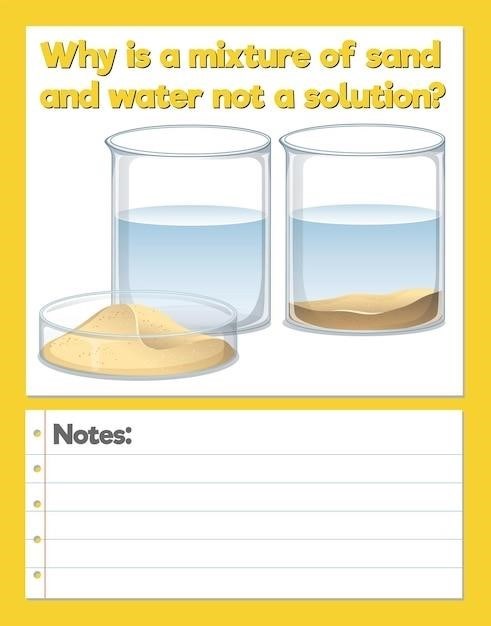Classification of Matter⁚ Worksheet PDFs
Numerous online resources offer printable worksheets on matter classification. These PDFs cover various aspects, including identifying pure substances, mixtures, elements, and compounds, along with differentiating homogeneous and heterogeneous mixtures. Many include practice exercises and examples to solidify understanding.
Types of Matter
Matter, anything that occupies space and possesses mass, is broadly classified into two primary categories⁚ pure substances and mixtures. Pure substances, in turn, are subdivided into elements and compounds. Elements are fundamental substances composed of only one type of atom, unable to be broken down further by chemical means. Examples include oxygen (O), iron (Fe), and gold (Au). Compounds, conversely, are formed from the chemical combination of two or more elements in fixed ratios, possessing distinct properties different from their constituent elements. Water (H₂O), table salt (NaCl), and carbon dioxide (CO₂) serve as common examples. Understanding these fundamental distinctions is crucial for effectively classifying matter.
Worksheets often utilize diagrams and illustrations to help students visualize the atomic structure of elements and the molecular structure of compounds, enhancing comprehension. The ability to differentiate between elements and compounds is a foundational concept in chemistry, providing a basis for exploring more complex chemical phenomena and reactions. The clear distinction between elements and compounds is critical for understanding chemical properties and behavior.
Pure Substances vs. Mixtures
A core concept in matter classification distinguishes between pure substances and mixtures. Pure substances, whether elements or compounds, have a uniform and definite composition throughout. Their properties remain constant regardless of the sample size or source. In contrast, mixtures consist of two or more substances physically combined, retaining their individual properties. The composition of a mixture is variable; it can be altered without changing the identity of the components. This fundamental difference is a key focus of many classification worksheets.
Worksheets often present students with scenarios requiring identification of substances as either pure or mixtures. Examples might include distinguishing between pure water and saltwater, or comparing a homogeneous mixture like air with a heterogeneous mixture like sand and water. Visual aids, such as diagrams showing the arrangement of particles in pure substances versus mixtures, are frequently employed to aid understanding. Mastering this distinction is pivotal for further study of chemical reactions and properties.
Elements and Compounds
Understanding the difference between elements and compounds is crucial in matter classification. Elements, the fundamental building blocks of matter, consist of only one type of atom. They cannot be broken down into simpler substances through chemical means. Examples include oxygen (O), iron (Fe), and gold (Au). Their unique properties are determined by the number of protons in their atoms (atomic number).
Compounds, on the other hand, are pure substances formed when two or more different elements chemically combine in fixed ratios. These chemical bonds create new substances with properties distinct from their constituent elements. For example, water (H₂O) is a compound composed of hydrogen and oxygen atoms. The properties of water are vastly different from those of hydrogen and oxygen gases. Worksheets often use molecular diagrams or chemical formulas to help students distinguish between elements and compounds, emphasizing the concept of chemical bonding and fixed ratios.
Homogeneous vs. Heterogeneous Mixtures
Differentiating between homogeneous and heterogeneous mixtures is a key concept in matter classification. A homogeneous mixture has a uniform composition throughout; its components are evenly distributed at a microscopic level, making it appear as a single phase. Examples include saltwater, air (a mixture of gases), and sugar dissolved in water. In these mixtures, you cannot visually distinguish the individual components.
Heterogeneous mixtures, conversely, exhibit non-uniform composition. Their components are not evenly distributed, and distinct phases or regions with different properties are visible. Examples include sand and water, oil and water, and a salad. You can easily see the individual components in these mixtures. Worksheets often present images or descriptions of different mixtures to test students’ ability to distinguish between homogeneous and heterogeneous based on the visual appearance and distribution of components.
Identifying Mixtures
Many worksheets focus on developing the skill of mixture identification. Students are presented with various scenarios or images representing different materials and asked to classify them as mixtures or pure substances. The process often involves analyzing the visual appearance of the material. If distinct components are visible, it’s likely a heterogeneous mixture. If the composition appears uniform, it could be a homogeneous mixture or a pure substance. Further investigation might be needed to differentiate between homogeneous mixtures and pure substances.
Some worksheets incorporate questions that require students to list the components of a given mixture. This reinforces the understanding that mixtures are composed of two or more substances that are physically combined but not chemically bonded. The ability to identify and list components demonstrates a grasp of the fundamental concept of mixtures and their composition. Furthermore, some exercises may challenge students to devise methods for separating the components of a mixture, highlighting the physical nature of the combination.
Classifying Changes in Matter (Physical vs. Chemical)
A significant portion of classification of matter worksheets focuses on distinguishing between physical and chemical changes. These worksheets often present students with a series of scenarios describing changes in matter, requiring them to categorize each change as either physical or chemical. Physical changes alter the form or appearance of a substance without changing its chemical composition. Examples include changes in state (melting, freezing, boiling), dissolving, and crushing. In contrast, chemical changes result in the formation of new substances with different properties.
Worksheets might include examples like burning wood (chemical change), dissolving sugar in water (physical change), or breaking a glass (physical change). Students are prompted to identify the key differences, such as the production of a new substance (chemical change) versus a mere alteration in physical state or form (physical change). The ability to differentiate between physical and chemical changes is crucial for understanding the fundamental principles of matter transformation and reaction.
Worksheet Examples and Exercises
Many worksheets utilize a variety of question types to assess understanding of matter classification. Common examples include multiple-choice questions where students select the correct classification of a given substance (element, compound, homogeneous mixture, or heterogeneous mixture). Other exercises might involve matching activities, connecting terms to their definitions, or classifying images representing different types of matter. Some worksheets incorporate fill-in-the-blank exercises to test knowledge of key concepts, such as the definitions of pure substances and mixtures, or the differences between atoms and molecules.
More advanced worksheets might include open-ended questions requiring students to explain their reasoning behind classifying a particular substance or change in matter. These open-ended questions encourage critical thinking and a deeper understanding of the underlying concepts. Additionally, some worksheets may incorporate diagrams or illustrations of molecular structures, requiring students to analyze these representations to determine the type of matter depicted. The variety of question types ensures comprehensive assessment of student understanding.

Common Misconceptions about Matter Classification
Students often struggle differentiating between pure substances and mixtures, sometimes incorrectly classifying solutions as heterogeneous due to their uniform appearance. Another common misconception involves confusing elements and compounds; students may fail to recognize that compounds are formed from two or more elements chemically bonded together. The distinction between homogeneous and heterogeneous mixtures also presents challenges. Students might misclassify a mixture as homogeneous simply because the different components aren’t immediately visible to the naked eye.
Furthermore, understanding the difference between physical and chemical changes is crucial for correctly classifying changes in matter. Students frequently confuse physical changes (like dissolving salt in water) with chemical changes (like burning wood), leading to incorrect classifications. Addressing these misconceptions requires clear explanations, visual aids, and ample practice opportunities. Worksheets can be designed to specifically target these common areas of confusion, reinforcing the correct understanding through targeted exercises and examples.

Resources for Further Learning
Beyond worksheets, numerous online and offline resources can enhance understanding of matter classification. Interactive simulations allow students to visualize the arrangement of atoms and molecules in different substances, making abstract concepts more concrete. Educational videos provide engaging explanations and demonstrations, clarifying complex ideas through visual aids and real-world examples. Many reputable websites offer comprehensive lessons and quizzes on matter classification, supplementing classroom learning and providing additional practice exercises.
Textbooks designed for middle and high school chemistry courses provide detailed explanations and diagrams, often incorporating interactive elements and real-world applications. Furthermore, educational apps specifically designed for chemistry can offer interactive games and quizzes, making learning both fun and effective. These diverse resources cater to various learning styles, ensuring a deeper and more complete understanding of this fundamental chemistry concept. Seeking out these supplemental learning materials can significantly aid in mastering matter classification.
